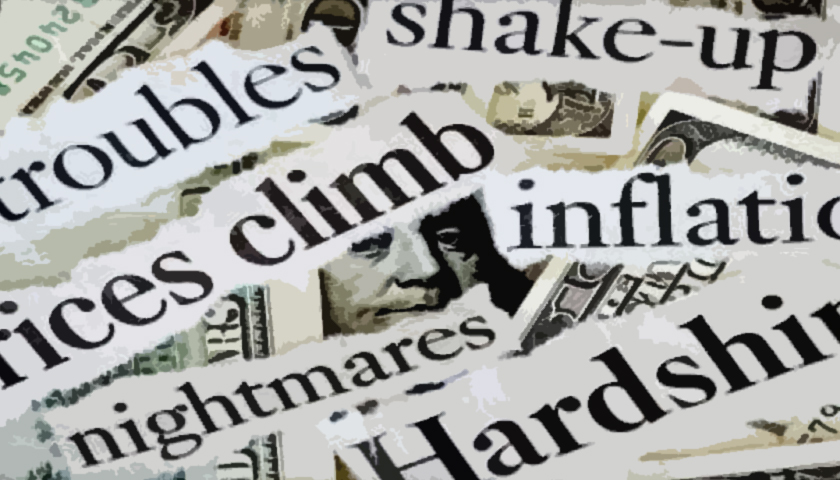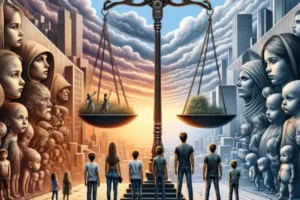Why We Know Trouble Is Coming
Every once in a while, you hear Ph.D.s, philosophers, and writers talking about the “coming war,” or an “inevitable disaster,” or something along similar lines. The central theme of this article is no different. However, one should ask themselves exactly how these people can be so darn certain that trouble is on the way. Can they predict the future? Surely not . . . right? It would be much easier to pass off the possibility of a domestic or global crisis as nothing more than an unfortunate chain of events or circumstances. Logic, history, and common sense do not allow for such naïve positions.
Figuring out that war or economic catastrophe is on the way is actually MUCH easier than attempting to look into the future. In fact, it is as easy as looking into the past. You have probably heard that history repeats itself at some point in your life. Have you ever given any real thought to that idea? Have you ever considered whether that statement was hyperbole or highly accurate?
I want to present the idea that it is not just hyperbole. The idea that history repeats itself is extremely accurate, but many simply refuse to believe that history can do such a thing. Perhaps it is because people see that we have things like computers and phones and know that those things simply did not exist in the past, so they give little thought to the idea that history can, in fact, repeat itself.
The fact is, when people say that history repeats itself, they are not referring to the technology or the actions of what you did this morning. Instead, they are referring to general ideas and events as a whole. For instance, these could include war, economic swings, periods of innovation, and so on. Most of these events are found to be extremely cyclical and sometimes even predictable.
Let us look at Rome, for instance. During my undergraduate studies, I was in a class called “Responsibility for the Future.” We examined numerous historical events and tried to learn as much as possible from each event. One such event was Rome’s collapse. The most compelling piece of data I reviewed was from researcher and senior policy analyst Jim Nelson Black (Black, 1994), who claimed to have found ten warning signs frequently present when a nation fell. He stated, however, that only 3-4 factors were needed to contribute to the collapse of the country’s government.
Those signs were as follows:
- Increase in crime and general contempt for the law.
- Loss of discipline and self-control in the economic arena.
- Increase in bureaucracy, regulation, and taxes.
- A decline in both the quality and the importance of education.
- Less attention paid to those qualities and principles which made the nation great.
- Loss of respect for established religion.
- Increasing materialism.
- Increasing immorality.
- Turning to foreign gods and worship.
- Less value is given to human life.
Upon review and a little bit of compare and contrast, I found that Jim Nelson Black was correct. Many nations since Roman times have collapsed, and just like he said, certain factors were present. Hence, it is probably a good idea to start paying attention when the factors begin to present themselves. This is an example of history repeating itself because certain factors show up before the collapse of a government.
Now, the scary part was that he had examined the similarities between the fall of Rome and the twentieth-century United States. Looking at the list of signs, can you guess what he found? We really do not need to cover his findings, though, do we? It really is self-evident when you simply view it with an open mind.
Still, other researchers have also found an interesting coloration between the demise of certain nations (including Rome) and one other extremely important factor; infrastructure, which of course, has already been demonstrated to be “lacking.”
But why stop there? There is so much more to the story. Have you heard of Dr. Alexander Fraser Tytler? Born in 1747, Tytler was a Scottish advocate, judge, writer, and historian who served as a Professor of Universal History and Greek and Roman Antiquities at the University of Edinburgh. Tytler is attributed with the theory of cycles concerning the rise and fall of nations. Today, that theory is known as “Tytler Cycle “(Tytler, 1834).
The theory is rather basic. What starts in bondage ends in bondage. The actual steps are as follows:
- “From bondage to spiritual faith;
- from spiritual faith to great courage;
- from courage to liberty;
- from liberty to abundance;
- from abundance to selfishness;
- from selfishness to apathy;
- from apathy to dependence;
- from dependency back again into bondage.“
We can clearly see reflections of our own nation inside of historical reference that alludes to the idea that history can, and perhaps even does, repeat itself and that perhaps we are staring certain inevitabilities right in the face. Apathy? Dependence on government? Bondage?
Of course, many of the low information masses think of bondage as chains. However, upon enough research, you will see that bondage also includes debt. So when you consider the nation’s lack of interest or concern with the state of our Union, the fact that about half of the nation (at the time of this writing) receives some kind of benefit from the federal government and that the majority of Americans are in some kind of debt, it is easy to see where we fall in this model.
To take it a bit further, let us look at some evidence that indicates we should be paying attention RIGHT NOW. For this demonstration, we will focus primarily on the United States so you can clearly see the threat that is upon us.
Since before 1500, there appear to be a few cycles at play. The scary part is that these cycles tend to present themselves like clockwork. There is an Inflation Cycle, an Economic Cycle, and a War Cycle that appear as though they simply cannot be stopped. I am sure this is primarily due to the ignorance that these cycles exist and utter arrogance or perhaps normalcy bias that does not allow us to believe that such things can exist.
Regardless, the Inflation cycle appears to be on roughly a 100-year cycle. This is a cycle of price inflation accompanied by what appears to be a general halt on the currency’s purchasing power. The last time this cycle showed its ugly little head was in 1901. Of course, we already know we are right in the middle of the next round of this cycle because the purchasing power is down substantially, and inflation is on the rise, threatening to skyrocket soon.
The next cycle is an economic cycle. This cycle includes several things but generally revolves around some kind of economic upheaval, expansion, or contraction. This cycle presents itself approximately every 60 to 70 years.
The third cycle is the war cycle. Some have called this the generational cycle because it appears to occur about every 4th generation or approximately every 80 years.
The problem is that each cycle is not exactly independent of itself. In fact, these cycles appear to play into one another and perhaps even rely on one another to perpetuate. This seems to be especially true for the Economic Cycle and the War Cycle.
Now, it must be understood that the dates can be played with a bit on this. So, in all fairness to the point and to keep this simple and relevant, we will focus on the economic cycle and the war cycle and use the latest dates since the creation of the United States to illustrate the point. Furthermore, we will use the 60 to 80-year split since both models fall within that time period. If you would like to research further back and play with the dates yourself, you should be able to do so using the dates provided.
Historians contend that the Industrial Revolution really “broke out” between 1760 and 1780. This is the Economic cycle at play as this changed the economics of the world during that time substantially. More directly, it changed the way people made their money. On the cusp of this event was the American Revolution, which was between 1775 and 1783.
If we add 60 to 80 years to the end of that time period, we get a time span of 1843 to 1863. An interesting thing occurred during this time, an enormous railway expansion began, and railroads began to replace canals as a primary mode of transportation. This is an economic factor that once again changed how people made money. Right on cue, the Civil War started in 1861 and lasted until 1865.
So then we add 60 to 80 years to the end of 1865, and we get a time span of 1925 to 1945. Many of you are familiar with the great stock market crash that occurred on October 29, 1929. This would start what would later be known as the Great Depression, which changed everything economically around the world and changed the way people would make their money. As you guessed, the war came right along with it. World War II started in 1939 and lasted until 1945.
Now comes the interesting part. If we add another 60 to 80 years to 1945, you will notice we get a time span of 2005 to 2025. Pay attention because national and global economies are in upheaval, to say the very least, and the war drums are pounding louder than ever.
Some of you have already put the bigger picture together. That picture, of course, being that close scrutiny of the cycles presented in this article, paints a much more horrible picture. Not just two cycles, but ALL of the cycles presented in this article appear to align between 2005 and 2025.
We can see we have the majority of the factors presented by Jim Nelson Black; we are definitely on the backend of Tytler Cycle, we are in the middle of the Inflation Cycle, we are currently witnessing the Economic Cycle, and we are waiting on the War Cycle. We have seen all the necessary reasons and covered the most noticeable players.
Using even basic observation, it is not hard to see where we are headed. The scary part is that it is not often that all of these events align in such a way at the same time. This leads me to believe that the level of effect will be substantially higher than ever presented before in recent history. Perhaps this is why we are seeing governments around the world prepare for what seems to be inevitable.
Keep in mind that this information is not being shared to scare you. Instead, it is being shared to prepare you. Look at it this way, if you ignore this warning and the information is right, the result for you could be catastrophic. If you heed this warning and the information is wrong, you have lost nothing.
It can be scary to imagine what appears to be inevitable. There are so many unknown factors, and we are still trying to gauge if it will be over resources, some attempt at global dominance (like WWII), or something else altogether. There are many ways this could go down. This is why it is so vital that you have a solid understanding of the threats before they arrive at your door.
Prepare now!




